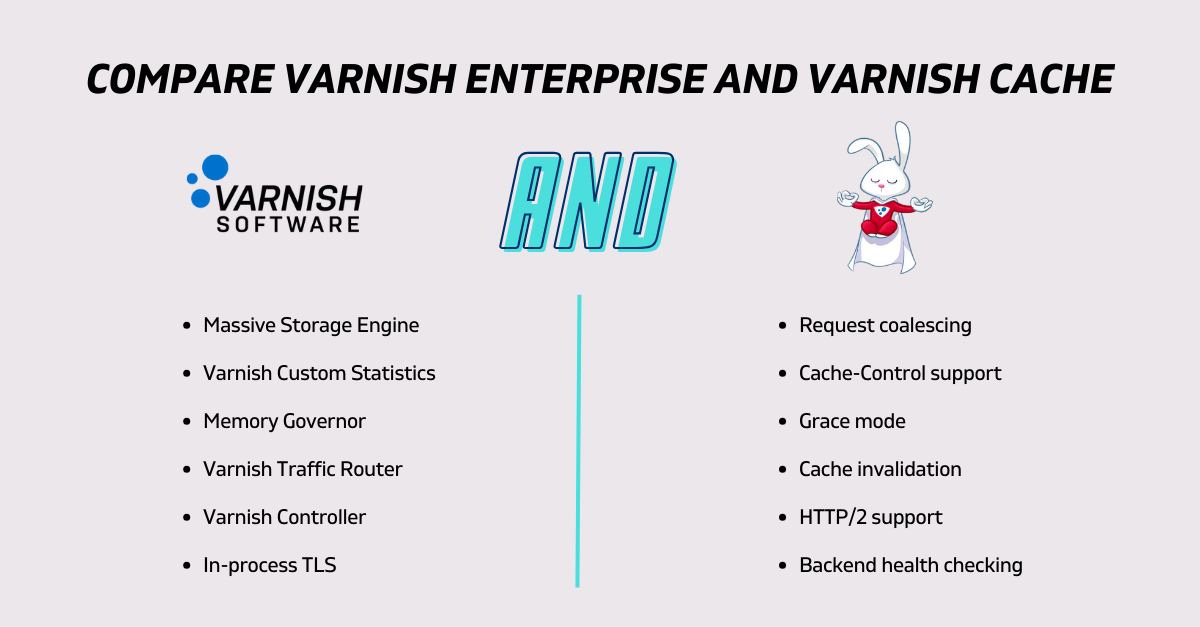This article is intended as a reference guide for users looking for a side-by-side comparison of the features found in the open-source Varnish Cache and the commercial offering Varnish Enterprise.
There are two types of features here: capabilities found in the core Varnish caching engine, and Varnish modules (VMODs), which are extensible and flexible add-ons that allow a modular approach to caching optimization and customization. VMODs expose their API in Varnish Configuration Language (VCL), so VMODs essentially extend the capabilities of VCL. For a more detailed look at what each feature or VMOD does, you can take a look at:
Varnish Cache Features
Varnish Cache is fast and stable, offering a rich feature set.
|
|
Varnish Enterprise Features
Varnish Enterprise includes these cache features and adds:
|
Feature |
Description |
Varnish Cache |
Varnish Enterprise |
|
Massive Storage Engine (MSE) |
An optimized dual-layer storage solution for persistent caching, and a cost-effective way to increase cache size using disk |
✖ |
✔ |
|
Varnish High Availability (VHA) |
A multi-master object replication suite that reduces backend traffic by replicating object in the cluster |
✖ |
✔ |
|
Varnish Controller |
A GUI and API to administer all the Varnish servers in your setup |
✖ |
✔ |
|
Varnish Traffic Router |
Request routing via HTTP or DNS based on customizable rulesets |
✖ |
✔ |
|
Varnish Custom Statistics (VCS) |
A statistics engine to aggregate, display and analyze user web traffic and cache performance in real time |
✖ |
✔ |
|
Varnish Broadcaster |
Broadcasts client requests to multiple Varnish nodes from a single entry point |
✖ |
✔ |
|
In-process TLS |
TLS termination in the Varnish core |
✖ |
✔ |
|
Backend TLS/SSL |
Connect to backend servers over TLS/SSL, ensuring end-to-end encryption |
✖ |
✔ |
|
Varnish Discovery |
Autoscale Varnish in cloud or container services |
✖ |
✔ |
|
Memory Governor |
Dynamic cache sizing and control over Varnish worker process footprint |
✖ |
✔ |
|
Parallel ESI |
Process Edge Side Includes (ESI) in parallel, rather than sequentially as in Varnish Cache |
✖ |
✔ |
|
TCP-only Probes |
Perform health checks on backends without sending an HTTP request |
✖ |
✔ |
|
Last Byte Timeout |
Modify timeouts from VCL, including overriding on a per-request basis and defining how long Varnish waits for full backend responses to complete |
✖ |
✔ |
|
Per-Backend Health Counter |
Insight into backend health without needing to directly deal with probes |
✖ |
✔ |
|
Scoreboard |
Detailed information about Varnish instances, for debugging and performance troubleshooting |
✖ |
✔ |
These Varnish Enterprise features achieve multiple objectives:
- Cater to more complex workloads and a wider variety of use cases e.g. edge storage for video on demand, traffic routing across private CDNs.
- Improve day-to-day Varnish performance e.g. better origin offload, more efficient memory management, compression.
- Make processes much faster e.g. auto-scaling and provisioning in Controller.
Varnish Modules (VMODs)
Varnish is made up of a core caching engine, edge language (VCL), and a library of pluggable modules for extending default Varnish behavior. Varnish Cache contains some VMODs as standard, while many others are available from the open-source community. Varnish Enterprise comes with 45+ VMODs for a wider range of capabilities and easier management of Varnish. Of course, it’s also possible to build your own!
|
Varnish Module (VMOD) |
Varnish Cache |
Varnish Enterprise |
|
Utilities for VCL Data (vmod_blob) Utilities for encoding and decoding the VCL data type BLOB |
✔ |
✔ |
|
Cookie Handling (vmod_cookie) Inspect, modify, and delete client-side cookies |
✔ |
✔ |
|
Load Balancing and Sharding (vmod_directors) Group multiple backends and load balance requests between them |
✔ |
✔ |
|
PROXY Protocol Information Retrieval (vmod_proxy) Extract TLV attributes from connections made with PROXY protocol |
✔ |
✔ |
|
Soft Purge (vmod_purge) Perform soft purges |
✔ |
✔ |
|
Basic Functions (vmod_std) Custom log messages, Query string sorting, Request body caching, Filesystem access |
✔ |
✔ |
|
UNIX Domain Socket Information Retrieval (vmod_unix) Provides information about the credentials of the peer process |
✔ |
✔ |
|
Test Cases (vmod_vtc) A utility module for varnishtest |
✔ |
✔ |
|
Content Localization (vmod_accept) Content negotiation and sanitization module that inspects the content of HTTP request headers |
✔ |
✔ |
|
Cryptographic Functions (vmod_digest) |
✔ |
✔ |
|
Header Manipulation (vmod_header) Modify and change complex HTTP headers |
✔ |
✔ |
|
Per-object Backend Blacklisting (vmod_saintmode) |
✔ |
✔ |
|
String Manipulation (vmod_str) A string manipulation module |
✔ |
✔ |
|
Transfer Rate Limiting (vmod_tcp) |
✔ |
✔ |
|
Variable Support (vmod_var) Support strings, integers and real numbers in VCL |
✔ |
✔ |
|
Rate Limiting (vmod_vsthrottle) |
✔ |
✔ |
|
Basic Key-based Purging (vmod_xkey) Perform tag-based invalidation |
✔ |
✔ |
|
Detailed Cache Metrics (vmod_accounting) |
✖ |
✔ |
|
Dynamic Access Control Lists (vmod_aclplus) ACL module that doesn't need access control information to be explicitly defined in VCL, but can store ACLs as a string |
✖ |
✔ |
|
Dynamic Load Balancing (vmod_activedns) DNS updates at runtime |
✖ |
✔ |
|
Akamai Connector A module that synchronizes Akamai CDNs with Varnish |
✖ |
✔ |
|
AWS VCL (vmod_aws) Access AWS services, including request signing, S3, Secrets Manager |
✖ |
✔ |
|
Brotli Compression (vmod_brotli) Brotli is the go-to compression algorithm for web content, providing better compression rates than legacy gzip compression |
✖ |
✔ |
|
Advanced Cookie Handling (vmod_cookieplus) Improved cookie modification, allowing interaction with Cookie header on request side and Set-Cookie header on response side |
✖ |
✔ |
|
Cache Encryption (vmod_crypto) Encrypt data at rest in the cache, headers and body using AES encryption. |
✖ |
✔ |
|
Device Intelligence (vmod_deviceatlas) Device detection using the Device Atlas database (subscription required) to match User-Agent with client-device information |
✖ |
✔ |
|
Edge-side Page Assembly (vmod_edgestash) A Mustache-based templating engine on the edge that parses JSON data into Mustache placeholders |
✖ |
✔ |
|
File Operations (vmod_file) A module that allows Varnish to interact with the file system, but also act as a fileserver |
✖ |
✔ |
|
String Building (vmod_format) A module for easy string formatting, based on the ANSI C printf format |
✖ |
✔ |
|
Advanced Header Manipulation (vmod_headerplus) Add, remove, update or retrieve any HTTP header |
✖ |
✔ |
|
Synchronous and asynchronous HTTP fetch (vmod_http) Implement content prefetching or other business logic where an HTTP request to an external server is necessary |
✖ |
✔ |
|
Image Compression (vmod_image) Convert and resize images to WEBP on the fly |
✖ |
✔ |
|
JSON Parsing (vmod_json) A JSON parsing and introspection module |
✖ |
✔ |
|
JWT Verification (vmod_jwt) Inspect, verify, modify and issue JSON Web Tokens (JWT) on the edge |
✖ |
✔ |
|
Key Value Store (vmod_kvstore) A high-performance in-memory key-value store with optional TTLs |
✖ |
✔ |
|
Least Connections Director (vmod_leastconn) |
✖ |
✔ |
|
Geo-Location (vmod_mmdb) Geolocation using the MaxMind GeoIP database to localize users based on their IP address |
✖ |
✔ |
|
Health Probes Proxying (vmod_probe_proxy) |
✖ |
✔ |
|
Bot Verification (vmod_resolver) Perform Forward Confirmed reverse DNS (FCrDNS) on a client IP |
✖ |
✔ |
|
Rewrite (vmod_rewrite) Reduces the amount of VCL needed to perform URL and header manipulation |
✖ |
✔ |
|
Per-session Modification (vmod_session) Control the idle timeout of the TCP session |
✖ |
✔ |
|
S3 Dynamic Backends (vmod_s3) Use Varnish as a caching proxy in front of S3, including a dynamic backend director for S3 bucket endpoints |
✖ |
✔ |
|
Cache Range Requests (vmod_slicer) Cache and stitch together ranges of a response, for large file delivery and video streaming |
✖ |
✔ |
|
Execute SQL Statements (vmod_sqlite3) Interact with an SQLite3 database in VCL |
✖ |
✔ |
|
Stale-If-Error (vmod_stale) A convenient and elegant way to implement Stale-If-Error logic in Varnish |
✖ |
✔ |
|
Prometheus Integration (vmod_stat) |
✖ |
✔ |
|
Synthetic Backends (vmod_synthbackend) Insert synthetic objects into the cache as if they were generated by regular backends |
✖ |
✔ |
|
TLS Querying (vmod_tls) |
✖ |
✔ |
|
Load Balancing (vmod_udo) |
✖ |
✔ |
|
URI Parsing (vmod_uri) Parse and manipulate URIs from VCL |
✖ |
✔ |
|
URL Parsing (vmod_urlplus) URL inspection and manipulation |
✖ |
✔ |
|
Utility Functions (vmod_utils) A collection of utility functions collected |
✖ |
✔ |
|
Web Application Firewall (vmod_waf) An add-on module that makes Varnish behave like a Web Application Firewall by leveraging the ModSecurity library |
✖ |
✔ |
|
Body Access and Transformation (vmod_xbody) Access and modify request and response bodies |
✖ |
✔ |
|
Improved Key-based Purging (vmod_ykey) Tag-based invalidation with more features and better performance on MSE |
✖ |
✔ |
While Varnish users can write their own VMODs to achieve great things, the fact that this wide range of VMODs comes pre-packaged in Varnish Enterprise makes usage faster, simpler and more secure - they are optimized, debugged and crash tested by Varnish experts!
Time for a deep dive on Varnish?
If you’re looking for an in-depth discussion of all of these features, and practical tips on using them in your caching operations, get Varnish 6 By Example now!
It’s a practical book full of tips and best practices for getting the most out of your Varnish setup and reaching new heights in your caching operations, whether you’re new to Varnish or an experienced pro.
Take the next step
If you’re looking to further optimize your web delivery infrastructure, our team of Varnish core engineers and experts are on hand to discuss your use case and help with HTTP delivery pain points. Get in touch here.
/VS-logo-2020-197x60.png?width=136&height=60&name=VS-logo-2020-197x60.png)




